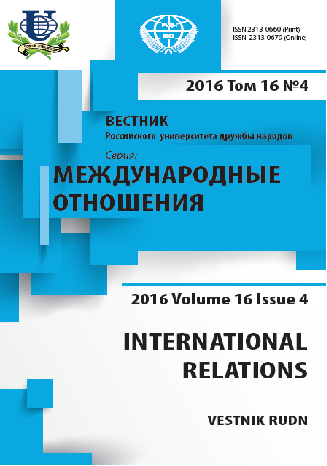The East-Asian vector of the Indian external policy: priorities in the South-East Asia
- 作者: Galistcheva N.V.1
-
隶属关系:
- Moscow State Institute of International Relations (MGIMO-University), Ministry of Foreign Affairs of the Russian Federation
- 期: 卷 16, 编号 4 (2016): Iran and India in the System of International Relations
- 页面: 643-653
- 栏目: Articles
- URL: https://journals.rudn.ru/international-relations/article/view/15438
- DOI: https://doi.org/10.22363/2313-0660-2016-16-4-643-653
如何引用文章
全文:
详细
The aim of this research is the analysis of the key direction of the East-Asian vector of the Indian external economic policy in 1990-2000s - its ties with the South-East Asian countries. The article highlights the main direction of the Indian government’s policy in the region - trade cooperation. The author examines the composition of the Indian exports to the South-East Asian countries and imports from this region as well as the main trade partners. The article also presents statistical data on the Grubel-Lloyd Index which measures India and the ASEAN-countries intra-industry trade of five main import and export products. The article also highlights the current bilateral investment interaction. It is noted that the investment cooperation between India and the South-East Asian countries is characterized by significantly higher activity of Indian investors. As a whole it helps accelerating bilateral economic relations. The author notes the mechanism of the Indian assistance to the South-East Asian countries and points out that providing assistance India wins markets for their products as well as favorable conditions for its companies to penetrate the South-East Asian region which ultimately stimulates the growth of bilateral trade. The author stresses that the Indian policy of providing assistance aims at consolidating its economic positions in the region as well as at spreading its geopolitical influence. The article presents statistical data characterizing the present state of the Indian external economic ties with this region.
作者简介
Natalia Galistcheva
Moscow State Institute of International Relations (MGIMO-University), Ministry of Foreign Affairs of the Russian Federation
编辑信件的主要联系方式.
Email: galistcheva@yandex.ru
Moscow, Russia
参考
- Berger, Ya. M. (2006). Kitai – global’naya derzhava 21 v.? [Is China a global state in the 21st century?]. Aziya i Africa segodnya, 8, pp. 2-12.
- Galishcheva, N.V. (2013). Indiya v mirivom khozyaistve na rubezhe vekov: vneshneekonomicheskie svyazi i vneshneekonomicheskaya politika [India in the world economy at the turn of the century: international economic ties and external economic policy]. Moscow: Buki Vedi.
- Galishcheva, N.V. (2011). Indiya – novyi finansovyi donor [India is a new financial donor]. Aziya i Africa segodnia, 8, pp. 16-22.
- Galishcheva, N.V. (2011). Sovremennaya vneshneekonomicheskaya strategiya Indii: sotrudnichestvo “Yug”-“Yug” [Contemporary External Economic Strategy of India: “South – South” Cooperation]. Vestnik MGIMO-Universiteta, 5(20), pp.96-106.
- Inostrannaya pomoshch’ [The Foreign aid]. (2013). Ed. by Kapitsa L.M. Moscow: MGIMO-Universitet.
- Sedov, I.A. (1971). Ekonomicheskie svyazi Indii s razvivayushchimisya stranami Azii i Afriki [Indian economic relations with the developing countries of Asia and Africa]. Moscow: Izdatel’stvo Nauka. Glavnaya redaktsiya vostochnoi literatury.
- Bijoy, C.R. (2010). India: Transiting to a Global Donor. Campaign for Survival and Dignity. The Reality of Aid. Special Report on South-South Cooperation. URL: http://www.realityofaid.org/userfiles/roareports/roareport_3ce2522270.pdf (accessed: 20.10.2011).
- Frankel, Francine R. (2011). The Breakout of China - India Strategic Rivalry in Asia and the Indian Ocean. Journal of International Affairs, 64 (2). URL: http://c.ymcdn.com/sites/www.india-us.org/resource/resmgr/docs/article_by_francine_frankel.pdf (accessed: 01.05.2012).
- Hariharan, S.V., Jebaraj, J. (2003). Trade between SAARC and other Developing Countries. New Delhi: Serials Publications.
- Kapila, U. (2005). Indian Economy. New Delhi: Academic Foundation.
- Murdock, Paul I. (2011). Tiger, Tiger Burning Bright - or Not? India-US Relations in the 21st Century. US Naval War College. Strategic Research Department. Research Report 6-96. URL: http://www.dtic.mil/cgi-bin/GetTRDoc?AD=ADA313473 (accessed: 19.05.2012).
- Price, G. (2005). Diversity in Donorship: the Changing Landscape of Official Humanitarian Aid. India’s Official Aid Programme. Humanitarian Policy Group Background Paper. URL: http://www.odi.org.uk/resources/docs/416.pdf (accessed: 15.02.2011).
- Qi, Huaigao (2009). China’s New Neighbouring Diplomacy. Contemporary International Studies, Sept./October, pp.89-110.
- Yhome, K. India-Myanmar Relations (1998-2008). A Decade of Redefining Bilateral Ties. Delhi: Observer Research Foundation, 2009. URL: http://www.observerindia.com/cms/export/orfonline/modules/occasionalpaper/attachments/ind-myn-OP_1236338801296.pdf (accessed: 16.03.2011).
- Connecting Asia: Infrastructure for Integrating South and Southeast Asia. (2016). ADB, 2016. Ed. by Michael G.Plummer et al. URL: https://www.adb.org/sites/default/files/publication/180191/adbi-connecting-asia-infrastructure-integrating-south-southeast-asia.pdf (accessed: 02.10.2016).








